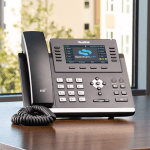In the fast-paced world of business, effective communication is key to success. Managed networks provide a seamless way to enhance communication and streamline operations. Let’s explore some innovative ways these networks can boost your business communication.
1. Enhanced Security Measures
Managed networks help safeguard sensitive communication by providing top-notch security protocols and regular updates, ensuring your business information remains confidential and protected. With cyber threats constantly evolving, businesses cannot afford to overlook security measures. A managed network comes equipped with advanced firewalls, intrusion detection systems, and encryption protocols, offering multiple layers of defense against potential breaches. Regular security audits and updates ensure that your network stays ahead of the latest threats, giving you peace of mind and allowing your team to focus on what they do best.
Furthermore, managed networks offer the benefit of centralized control over security settings, which simplifies maintaining a consistent security posture across all devices and locations. This uniformity is crucial for businesses with distributed teams or multiple offices, ensuring that all employees adhere to the same security standards. As cyberattacks grow in sophistication, a managed network’s ability to adapt and respond swiftly becomes an invaluable asset for maintaining secure business communications.
2. Improved Connectivity and Accessibility
A managed network enhances connectivity, making it easier for teams to communicate and access necessary data and tools efficiently from anywhere, whether they’re in the office or working remotely. This enhanced connectivity allows for greater flexibility in work arrangements, enabling employees to remain productive no matter where they are. Moreover, with the rise of remote work, having a reliable network that allows seamless access to files and applications becomes essential in maintaining business continuity.
Additionally, modern managed networks support the integration of cloud services, which facilitates real-time collaboration and information sharing. This integration helps in breaking down geographical boundaries, fostering a more inclusive and dynamic work environment. Teams can engage in virtual meetings and work on shared documents simultaneously, greatly enhancing their ability to collaborate effectively and make faster, data-driven decisions.
3. Streamlined Data Sharing
With seamless data sharing capabilities, managed networks ensure that important information is easily accessible and shared across departments, avoiding communication lags and bottlenecks. This is particularly beneficial for decision-making processes, where timely access to accurate data can make all the difference. By eliminating the silos that often exist within organizations, managed networks facilitate a more cooperative form of data sharing, enabling teams to work more cohesively and efficiently.
Managed networks utilize advanced data management tools to categorize and prioritize the flow of information, ensuring that the most relevant data is readily available to those who need it. This organizational clarity prevents miscommunication and redundancy, further optimizing workflow efficiency. By serving as a central hub for all business communications, managed networks ensure that everyone is on the same page, thus boosting overall organizational productivity.
4. Unified Communication Platforms
Managed networks often incorporate unified communication platforms, integrating tools like email, messaging, and video conferencing into one system for improved efficiency and ease of use. Such integration simplifies communication by eliminating the need to juggle multiple applications. When all communication channels are consolidated, workflows become smoother, and employees can quickly switch contexts without the hassle of logging into multiple services.
The use of unified communication platforms also enhances team collaboration by ensuring everyone can communicate in a medium that suits them best. Whether it’s a quick instant message or a detailed video call, these platforms provide the flexibility needed to accommodate different communication preferences. As a result, the chance of misunderstandings diminishes, and interpersonal collaboration improves, leading to stronger team dynamics and better project outcomes.
5. Cost-Effective Communication Solutions
By streamlining services and reducing unnecessary complexity, managed networks offer cost-effective solutions that eliminate redundant expenses and optimize communication budgets. This streamlined approach allows businesses to allocate their resources more efficiently, focusing funds on areas that directly impact growth and innovation. Furthermore, the predictability of costs associated with managed networks enables better financial planning and budgeting.
Managed networks also reduce costs by minimizing the need for in-house IT staff to engage in constant maintenance and troubleshooting of communication systems. Instead, these networks come with dedicated support services that handle issues proactively, further reducing the total cost of ownership. Companies can then reinvest these savings into developing new products, expanding into new markets, or enhancing employee training, all of which contribute to sustained business success.
6. Enhanced Collaboration Tools
Managed networks often come equipped with tools that encourage collaboration, such as shared calendars and task management apps, fostering a more coordinated team environment. These tools facilitate clear communication about deadlines, responsibilities, and project statuses, promoting accountability and ensuring that all team members are aligned on their objectives.
In addition, collaborative platforms supported by managed networks can integrate with third-party applications, enhancing the overall productivity ecosystem. Whether it’s connecting with CRM software or project management hubs, these integrations allow teams to harness the power of their entire tech stack effectively. This interconnected approach creates a seamless workflow, where information flows freely, and collaboration opportunities abound, driving innovation and growth.
7. Higher Reliability and Uptime
With dedicated support and monitoring, managed networks provide higher reliability, minimizing downtime and ensuring that your communication channels are always operational. This reliability is crucial in a business world that expects instant communication and zero delays. Managed networks offer resilience against outages and technical failures, thanks to their ability to provide ongoing system maintenance, updates, and redundancy measures.
Ensuring high levels of network uptime is not just about maintaining business operations; it’s also about protecting a company’s reputation. Clients and partners expect consistent communication, and any lapse can lead to reduced confidence and missed opportunities. Managed networks mitigate such risks by prioritizing network stability and offering quick response times in the event of technical difficulties, keeping business communications intact and uninterrupted.
8. Scalable Network Solutions
As your business grows, managed networks can easily scale to meet increased demand, ensuring that communication infrastructures are never outgrown and can evolve with your needs. This scalability provides a significant advantage for rapidly growing businesses, enabling them to expand their operations smoothly without the need for extensive overhauls of their existing communication infrastructure.
The ability to scale effectively is supported by the modular design of managed networks, which allows for the incremental addition of resources and capabilities. Businesses can stay agile and responsive to market changes, quickly adjusting their communication strategies and network capabilities to seize opportunities or address challenges as they arise. This adaptability not only ensures operational efficiency but also stimulates sustainable business growth.
9. Proactive Network Management
With proactive monitoring and management, potential issues are identified and resolved before they impact communication, providing a smooth and continuous flow of information. This proactive approach to network management allows businesses to eliminate sources of potential disruption, ensuring that all lines of communication are maintained with optimal effectiveness and reliability.
In addition to problem detection, proactive network management involves trend analysis and predictive maintenance, allowing network administrators to anticipate and prepare for future communication needs. By leveraging advanced analytics, managed network providers can deliver customized solutions that align with business goals, optimizing network performance while minimizing risks. This future-proof approach to network management leads to consistent, uninterrupted business communication.
10. Simplified Network Administration
Managed networks simplify administration, freeing up your IT team to focus on strategic initiatives rather than being bogged down in daily maintenance of communication systems. By automating routine tasks and providing intuitive management interfaces, these networks eliminate the need for labor-intensive administrative processes.
The reduced administrative burden that comes with managed networks enables IT teams to engage more directly with business development activities, such as implementing innovative technologies and optimizing business processes to meet organizational goals. This not only enhances the overall efficiency of the IT department but also contributes positively to the company’s bottom line, maximizing the impact of technology investments.
11. Real-Time Data Access
Access to real-time data improves decision-making processes by allowing teams to communicate based on the latest information, leading to more informed and timely business decisions. With instant access to accurate data, stakeholders can quickly adjust strategies and respond to market demands, gaining a competitive edge.
Moreover, maintaining a real-time communication environment fosters a culture of transparency and accountability. Teams are empowered to share insights and feedback as situations develop, ensuring everyone is aligned and informed of the most current developments. This promotes a proactive approach to business challenges and encourages collaborative problem-solving across all levels of the organization.
12. Increased Efficiency and Productivity
With managed networks, businesses can experience increased efficiency and productivity as streamlined communication processes reduce time wasted and improve output quality. Efficient communication ensures that employees are more focused and spend less time navigating technological hurdles, resulting in increased throughput and smoother operations.
Ultimately, the efficiencies gained from a managed network impact the overall business culture by promoting an environment where employees are encouraged and empowered to collaborate, innovate, and execute tasks more effectively. This improved productivity is reflected in higher profitability and sustained business growth, demonstrating the transformative impact that seamless communication can have when supported by a robust managed network.




